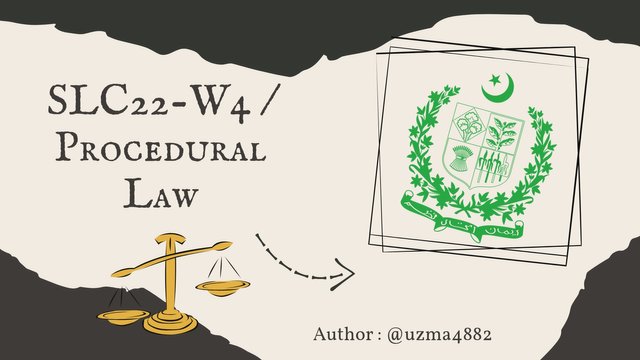SLC22-W4| Procedural Law | Family Act 1964 is a Procedural Law in Pakistan

Greetings to everyone!!!
According to what was explained in class, you must do the following

Legal laws are the rules and procedures that govern the process by which courts enforce rights and responsibilities for the equal facilitation of the public and betterment of the nation. They explain how cases are brought, heard and decided to ensure justice is served. These laws focus on the processes and procedures related to the judicial process, including the trial, presentation of evidence, first instance, appeals and use of judgment, but do not deal with the rights themselves. Procedure and Family Court Act 1964.
A. Choose a law from your country and explain why you consider it a Procedural Law or part of Procedural Law.
Yes, the Family Courts Act, 1964 is considered as the procedural law in Pakistan, Although it contains some important provisions. Its main objective is to develop methods and procedures for resolving family disputes effectively and efficiently. Pakistan has established family courts and has clarified their decisions on family matters. . The bill provides for the establishment of family courts in Pakistan and specifies the jurisdiction of these courts over family matters.
Resolve family problems like as divorce and material issues quickly by simplifying the process and reducing delays.
The Act is essentially a law as it governs the legal process for resolving family problems. However, it contains some articles regarding family rights and responsibilities.
By rapidly growing the population of the gender female especially the material issues are respectively increasing for dealing it Family procedural law is strictly enforced to resolve family material issues.
B. I indicated which of the principles of procedural law are present in that law and why.
The Family Courts Act, 1964 contains many important principles of the law to be effective, fair and accessible in resolving family disputes.
The law clearly limits the jurisdiction of the family court to matters such as marriage, divorce, alimony, maintenance and disputes.
- This principle of jurisdiction ensures that family matters are dealt with by courts with appropriate expertise. It eliminates the legal process and allows litigants to easily navigate the system which is important in family matters.
- The principle of speedy justice recognize the importance of speedy resolution of family disputes, the constitution embodies the goal of speedy justice by setting specific time periods for various procedures and limiting delays to avoid unnecessary delays.
- Fair Hearing Law ensures that both parties have the right to a hearing, which is the basis of the rule of law. It allows for the presentation of evidence and preserves integrity by allowing time for analysis. time. It eliminates restrictions and allows parties to represent themselves when necessary.
A.- Say, according to what you have seen in class, which of the facts of the case you identify with "Process", which you identify with "Procedure" and explain the reason for your answer.
Well, After reading this case , I acknowledged to define the situation and distinguish between process and process, we can divide the facts into the following groups.
| Process | Procedure |
|---|---|
| All laws have been initiated by Mr. Ramirez will terminate the contract as a result of this process. Because the procedure refers to all legal disputes from the filing of the complaint to its resolution, including all procedural procedures. | Here on, Building inspection is an example of a process because it is a specific action or step in a larger process. Procedures refer to individual processes, actions, or methods used to facilitate the resolution process, such as inspections, hearings, or evidence gathering. |
Therefore, the process is the entire judicial process and the process also includes procedural steps such as judicial review.
A.- According to what was explained in class, identify the procedural subjects and locate them in each of the characters present in the case. Explain why you gave your answer.
Well , The main part of the trial in this case is as follows:
Pedro: He is the plaintiff (actor), he is the plaintiff. Pedro is suing for damages resulting from the accident.
María: He is the defendant (demandada). Maria was accused because her car was involved in an accident and she was the driver who caused the accident.
Mr. Manuel:
He is the third party or intervener (tercerista). Since the car belongs to Mr. Manuel, he joined the case because it could affect his property (his car) even though he was not directly involved in the accident.
Pedro is classified as such because he is the plaintiff and seeks compensation and therefore is an actor. Ms. Maria is the defendant and is accused of causing the accident. Finally, Mr. Manuel is also important because the vehicle involved in the accident belongs to him, which may affect liability or interests in damages even if it is not directly related to the accident.
Here is the Link of Procedural Law | Family Court Act 1964👇 can access and acknowledge in detail aspects and principles that highlighted enforcement reasons to solve the family material issues
https://pakistancode.gov.pk/english/UY2FqaJw1-apaUY2Fqa-apaUY2Npa5lraQ%3D%3D-sg-jjjjjjjjjjjjj
| Discord | Uzma4882#9176 |
|---|---|
| Know About Me | Introduction |
| Club Status | #club5050 |
Upvoted! Thank you for supporting witness @jswit.